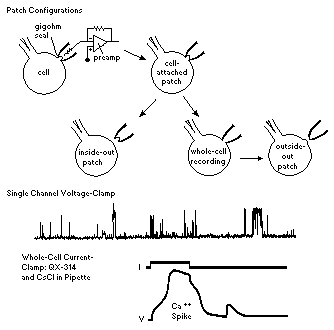
| Figure 2. |
 |
| Schematic of patch-clamp configurations and representative single-channel and whole-cell records. Upper panel: The same patch pipette and voltage-clamp amplifier setup can be used to record in four different configurations (see text for details). Single-channel recordings can be taken from three of the four configurations: cell-attached, inside-out and outside-out patches. Breaking the patch under the pipette (by suction) allows whole-cell voltage or current recording. Middle panel: A representative cell-attached patch recording (voltage-clamp mode) from a cultured CNS neuron, showing currents flowing through single ion channels. Single-channel activity appears as box-like upward events. At least two channels are present in this patch, as indicated by the different event amplitudes. Brief upward events are channel openings not fully resolved due to recording limitations (D. L. Gruol, unpublished observations). Lower panel: Representative whole-cell current-clamp recording of a hippocampal neuron in a slice preparation, recorded with a pipette containing QX-314 to block Na+ channels (fast spikes) and 140 mM CsCl to block K+ channels (G. R. Siggins, unpublished observations). This record was taken about 5 min after patching on and breaking into the cell; the Ca2+-dependent action potential (a broad depolarizing plateau without a fast Na+ component or afterhyperpolarizing potential) evoked by depolarizing current injection indicates the rapid equilibration allowed by this configuration, between the contents of the pipette and the cellular constituents. I = current, V = voltage. (Modified from Fig. 10 of ref. 5.) |
published 2000